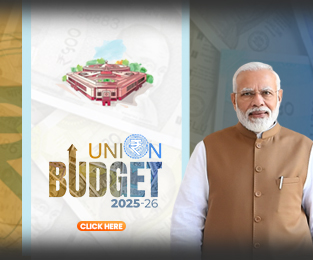
Date : April 20, 2019
Will 2019 Witness the Dynasty as a Liability on the Congress Party?
- Arun Jaitley
The first two rounds of the voting for the 2019 General Elections are over. What are the early trends? What are the initial lessons?
A comparison of three campaigns
The BJP/ NDA campaign is focussed. It sets the agenda. There is clarity about the leadership of Shri Narendra Modi. There appears to be a strong groundswell in his favour. The campaign focusses on major achievements of the past five years, particularly relating to strengthening the poor and the middle-class, a clean Government and a special emphasis on national security. The alliance is coherent and the issues being projected are focussed.
Based on fake issues, the key thrust of what the Congress was building up in the last one year, has cracked up. They are now concentrating on a new scheme declared in their manifesto which is cutting no ice with people. The entire reliance on the members of the first family to deliver a sustainable campaign is proving to be a non-starter. Wherever the contest is primarily between the BJP and the Congress, the BJP is comfortably placed.
The regional parties in West Bengal and Odisha may be in for a major surprise. The Left parties did badly in 2014. If at all, their parliamentary strength will weaken further. The regional parties will do well only in regions where the BJP still lacks major strength.
However, a major factor for a large part of the electorate, Prime Minister Modi appears to be the obvious choice. This is particularly true in the case of voters below 35 years of age. ‘My vote is for Modi’ is the general refrain from the ground.
The NDA is running a positive campaign. It looks at an India without poverty and which gives a much better quality of life to its people. The Congress and the regional parties concentrate on only removing one man – Narendra Modi. Where the incumbent’s acceptability is at 70%, they are whipping up a non-existent anti-incumbency.
The state of some caste based and dynastic parties
The Congress is seeing some of its traditional bright faces deserting the party. Are these desertions only because of particular incident or do they reflect a larger disillusionment with the leadership? When mindsets are feudal, dynasties survive. Dynasties also survive when they are charismatic and have an ability to deliver. A lot of supporters accept subjugation because of the ability of the dynasty to put them in positons. What happens to dynasties when the feudal mindsets change and nations become more aspirational? The socio-economic profile of India is moving up the growth ladder. It may be difficult for a country with this socio-economic profile to accept dynasties. If the Congress’s dynast has only an ability to deliver 44 seats or 60 seats in Parliament, what then is the incentive for conventional Congressmen to bear humiliation of subjecting themselves to a dynast? Ultimately, in dynastic parties one has to accept political slavery. These Congressmen today look at a party like the BJP where men and women of talent have a huge opportunity to move up, both in Party, legislatures and Governments. The two Prime Ministers which BJP gave to India, namely, Shri Atal Bihari Vajpayee and Shri Narendra Modi, were by a mile the tallest politicians of their generation. Today, this can happen in merit based parties, not in dynastic parties. A relevant question with this changing socio-economic profile of India is – “Are dynasties an asset for a party or are they a liability?” Unquestionably, the present generation of dynast has become a liability rather than an asset for the Congress Party.
A similar situation arises with regard to the caste based parties. This INLD has cracked up. BSP got zero in the Lok Sabha Elections in 2014 and 19 seats in the Assembly Elections. The SP could only retain seats for its family members in the 2014 elections. The RJD was down to two seats. Thus, the changing socio-economic profile of India is no longer conducive to caste based parties perpetuating indefinitely. The sun will slowly but surely come down on that era. Another important trend which is visible is that wherever national parties lack strength, the vacuum was filled up by strong regional parties. The BJP, which was a Party of the North, expanded to Central and Western India, and has now captured a large part of the political space in the East. To that extent, it has already consumed some of the space which was occupied by the regional parties of Bengal, Odisha, Assam and North-East. It is already lead player in the South in Karnataka. This election will witness BJP as a co-equal in Kerala. The unprecedented turnout at the Prime Minister’s Thiruvananthapuram rally on the 18th of April, would leave many scratching their heads for a reanalysis. The BJP has the ability to fight and occupy more political space from the regional parties is already visible. The Congress inherently lacks that instinct.
The direction of 2019
The direction of 2019 General Election is clear. The centre-stage is occupied by the BJP. Both in terms of agenda setting and leadership, the Congress is failing to make any impact. Regional parties are putting up a fight. Their agenda is mostly State based. The national vision in their leaders is lacking. The country doesn’t trust them to form a coherent, stable and long-lasting coalition. Can a federal front be trusted with an effective management of national security?
How does this election convert it into Parliamentary seats?
The momentum is clearly with the BJP and the Prime Minister Modi. In terms of national leadership contest for a Prime Ministerial election, it is almost becoming a one horse race. There is nobody else measuring up to Prime Minister Modi’s level of capacity and acceptability.
Is history going to witness something wholly unprecedented? Are we going to witness the rejection of caste based and dynastic parties? And will aspirational India make a harsh judgement on electing a merit based leadership? This may well be the case.
[[[[[
To Write Comment Please Login



.gif)





